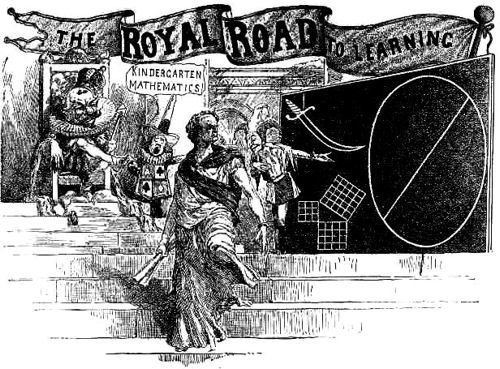



HISTORY TELLS HOW Euclid, the Greek mathematician and philosopher, who flourished 300 years B. C. while expounding the problem of subdividing the circle to King Ptolemy, was interrupted by the irate monarch exclaiming: “I am wearied by such dull lessons, and refuse to burden my memory with stupid rules!” Whereupon the great mathematician replied: “Then your majesty will graciously permit me to resign the position of Imperial instructor, for none but a fool knows of a Royal Road to Mathematics.”
“Right you are, Euc!” interjected Beppo, the court jester, as he pushed his way to the blackboard, “and, in accepting the position so gracefully tendered. I will proceed to demonstrate how the great principles of higher mathematics can be taught by simple kindergarten methods which children may understand and remember.”
“Philosophers say:” ‘what is learned with pleasure is never forgotten, but knowledge cannot be beaten into the head with a wormwood club.’ “Pupils should not be made to commit rules to memory; everything should be explained so that they can formulate rules in their own language. A pedagogue who teaches rules would be a good one to train parrots!”
“Dry mathematical problems are more digestible when presented in palatable form, and the mind becomes stored with valuable information when the illustrations are gleaned from the classical tidbits of history.”
“Mathematics, which constitutes the most important branch of learning, forms the groundwork of the arts and sciences, and is so essential to the successful man of affairs, as well as the development of a clear brain, that parents should realize the advantage of encouraging an early love for puzzles, tricks and problems among their children.”
“With the kind permission of your majesty,” continued Beppo. “we will now elucidate the subdivision of the circle by asking Tommy Riddles, the court crier whose learning is limited to the science of simple addition, to show into how many pieces it is possible to divide a German Pancake with seven straight cuts of a knife?”
“Furthermore, to add a point to the moral of the story of the sword of Damocles, which is shown to be suspended over our heads by single thread, we will proceed to impress it indelibly upon the memory by connecting it with a scientific and practical problem; Why is the blade of that scimitar always shown to be curved ?”
“Noting with pleasure the presence of the ‘Pons asinorum.’ the ass's bridge problem, which my distinguished predecessor has made famous as his 47th proposition, which proves that the square described on the long side of a right-angled triangle, termed the hypotenuse, is equal to the sum of the squares of the other two aides, I will ask the author of the 47th proposition to tell how many rails of equal length it would require to enclose a right-angled triangular field if one of the three sides was 47 rails long?”
“The clown's 47th proposition” will doubtless prove that many good mathematicians have much yet to learn regarding the wonderful principles of Pons asinorum which may be said to underlie the foundations of mathematics and geometry.
NOTE.‚Ä” ‚ÄúPons asinorum‚Äù originally applied to the 5th proposition -- First Book of Euclid -- that ‚ÄúThe angles at the base of an isosceles triangle are equal to one another.‚Äù
The clown's 47 problem is solved by the rule which produces a right angled triangle from any odd number, viz.: Square it; 47x47=2,209, Divide by 2, and make the hypoth. one greater than the base, Ans.: 47, 1,104 and 1,105. Strange that the fool should have hit upon a dimension to which we can find but one answer in whole numbers. There would? have been ten answers if he had said 48 rails. To find a triangle from any even number, square the given number and divide by 4. The quotient will be 1 more than the base and 1 less than the hypoth., viz.: 8x8=64, divided by 4=18, So the triangle would be 8, 17 and 19.
I really blush to give the fool's answer to "Why was the blade of that scimitar curved?" It was curved so that it would fit the scabbard!
[Page 7]